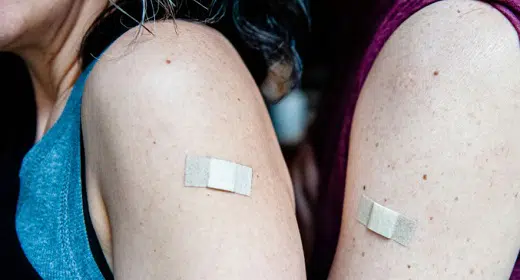by Amit Katmala: With clinical vaccine trials for everything from HIV to Zika, messenger RNA could transform medicine—or widen health care inequalities…
KATALIN KARIKÓ NEVER intended to make vaccines. For years before the pandemic, the Hungarian-American biochemist had been working to realize the therapeutic potential of mRNA—first trying to create a synthetic version of the messenger molecule that wouldn’t trigger the body’s inflammatory response, and then, once she and colleague Drew Weissman had achieved that goal, trying to get the medical and scientific community to pay attention.
She had envisioned the technology being used to treat those recovering from heart attacks and strokes. But it was the frantic race for a Covid vaccine that earned Karikó belated global recognition. The work she and her colleagues had done on mRNA provided the foundation for Moderna and BioNTech to quickly develop Covid vaccines that have now saved millions of lives.
Traditional vaccines train the immune system by introducing it to harmless versions of whole viruses—the body learns to recognize the virus’s key features, such as SARS-CoV-2’s infamous spike protein. These new mRNA vaccines found a more elegant way to achieve the same goal, using messenger RNA—a genetic molecule found throughout nature that’s used to transmit information within and between cells—to provide the body with a set of instructions on how to make the spike protein itself, essentially borrowing the body’s internal machinery and turning it into a photocopier.
This difference allowed mRNA vaccines to be designed, created, and approved in record time. Over the past 18 months, mRNA technology has been injected into billions of arms and has helped slow the devastating impact of the pandemic. But its long-term impact—accelerated by Covid—could be even greater. “It seems like the sky is the limit,” says Karikó. “Previously the belief was not there.”
Dozens of clinical trials are now underway for new forms of the mRNA vaccine—targeting everything from malaria to Zika, herpes, and cytomegalovirus. Last month, Moderna—which was founded in 2014 to explore the potential of mRNA—announced it had started Phase I clinical trials for two mRNA-based HIV vaccines. “The timeline for what can be achieved using the mRNA platform is so much better,” says Carl Dieffenbach, director of the Division of AIDS at the US National Institutes of Health, who is overseeing those trials.
There was some work on mRNA happening before the pandemic—Moderna had spent years on the lipid envelope that encases the strand of mRNA in the vaccine, for instance. “Like all overnight successes, mRNA has been in development for a long time,” says Richard Hatchett of the Coalition for Epidemic Preparedness Innovations (CEPI). The US Biomedical Advanced Research and Development Authority invested in an mRNA vaccine for Zika in 2016, but “the urgency sort of trailed off” as the outbreak subsided, Hatchett says. There had also been tentative attempts to develop mRNA platforms for other coronaviruses, such as MERS, work that proved crucial when Covid broke out. Moderna was able to tweak its MERS vaccine for the new disease, meaning its Covid vaccine entered clinical trials just 66 days after SARS-CoV-2’s genetic sequence was published.
It’s true that mRNA vaccines would probably have come to market eventually, but they were on what Dieffenbach calls “a leisurely stroll.” Covid “pressure-tested” them—advancing their emergence by years or decades. Karikó remembers organizing the first mRNA conference in 2013 and says that nobody in attendance would have expected an FDA-approved product less than 10 years later. “Because of the success against Covid, we’re going to see tremendous investment, and we’re going to learn just how flexible it is and how finely we can target,” says Hatchett.
One of mRNA’s strengths is its “remarkable agility,” as Hatchett puts it. Its only raw ingredients are the four nucleotides that form the “letters” of the RNA sequence, so it can be designed and made pretty rapidly. “Biological manufacturing is very hard and temperamental and has been difficult to introduce in many environments. It’s taken India decades to build up the vaccine manufacturing capability they have,” says Hatchett. “It may be easier for countries to develop an mRNA production capacity than traditional biological manufacturing capability.”
Developing countries could, Hatchett suggests, leapfrog over traditional vaccine-manufacturing processes and go straight to mRNA—mRNA plants are already being planned in countries across Africa and Asia. After Covid, they could be quickly repurposed to create vaccines for other diseases—all you need to do is change the order of the bases in the mRNA to give the body a new set of instructions. There are also far fewer concerns about purity or contamination than with traditional vaccines—the body quickly translates, expresses, and breaks down the strand of mRNA.
“mRNA is completely interchangeable,” says Jackie Miller, senior vice president for infectious diseases at Moderna. “What changes between the different vaccines is the DNA template that we utilize to synthesize the messenger RNA, but across all of our vaccine portfolio, we’re using the same lipid nanoparticle.”
CEPI wants to use that flexibility to create a library of mRNA vaccines against each of the viral families known to cause human disease. This would cost $20 billion to $30 billion, Hatchett estimates, but it would enable a rapid response to any new outbreaks. “The lesson from 2020 is that 326 days [the time from sequencing the genome of SARS-CoV-2 to administering the first doses of a Covid vaccine outside of trials] is terrific, astounding, and not fast enough,” he says. CEPI wants to be in a position to make a vaccine for emerging threats within 100 days. “mRNA is an essential, critical component of our being able to achieve that mission,” Hatchett says.
CEPI’s other goal is to improve access to mRNA vaccines, which still need to be stored and transported at extremely cold temperatures (–80°C for Pfizer/BioNtech, –20°C for Moderna), which makes reaching remote areas challenging. The cold chain requirement and the cost are two reasons the majority of mRNA vaccines have been purchased and administered by higher-income countries. In India, 88 percent of people received the AstraZeneca Covid vaccine, which is based on a different technology, doesn’t need to be kept so cold, and has been made available far more cheaply; in the US the overwhelming majority got mRNA vaccines.
That problem will never go away completely—mRNA is inherently unstable, Karikó says, to the point that vaccine shipments can be ruined by a bumpy road—but there is a trade-off between temperature and shelf life; you can store vaccines at less extreme temperatures, but they will degrade faster. “In some parts of the world, this is not the most convenient presentation,” Miller says. Although mRNA could eventually be cheaper than traditional vaccine manufacturing, that’s not the case today—and ensuring equitable access could require some technical breakthroughs. Dieffenbach suggests freeze-drying vaccine particles for easier transport and storage as one potential solution—eventually mRNA could be squirted up the nose, inhaled as a powder, or applied using a patch. Self-amplifying RNA, which replicates itself inside the body, could enable lower doses, which could lessen the risk of side effects.
Eventually, protection against multiple strains of a virus could be administered in a single shot. There are efforts to make universal vaccines for coronaviruses or influenza that would target their stable features—like the stalk of an influenza virus—getting around their ability to shift and mutate. “Even for those coronaviruses that are still in the bat and have not jumped to us, we will be protected,” Karikó says.
Or, if that doesn’t work, there’s also the “sledgehammer” approach of putting multiple strains of mRNA into a single jab—a whole manual of instructions the body can use to recognize different strains of a virus. “Our goal ultimately is to develop these individual antigens but combine them in ways that if you’re getting a seasonal booster you don’t need to get multiple, you can get a single booster to cover against the most likely respiratory pathogens,” Miller says. A future mRNA flu jab—the most likely next step after Covid—could comprise specific instructions for that season’s most prevalent strain, but also primers for various different strains so that if there is a pandemic of, say, H7N9 flu, people’s immune systems won’t be going into it completely blind.
There’s a world of applications beyond vaccines, too. Messenger RNA gives scientists and doctors a way to make essentially any protein they would like directly inside the body. Rather than coding for a spike protein to encourage the body to make antibodies against it, mRNA could be used to teach the body how to make those antibodies directly: Someone who survived an outbreak of an emerging disease could have their antibodies cloned, and the instructions for how to make them could be shared with others using mRNA, suggests Karikó.
Years ago, she made a list of all the diseases she thought it was reasonable to treat using mRNA. There were more than 30 on the list, covering everything from cancer to everyday aches and pains. The design of the lipid coating that surrounds the mRNA could be tweaked to get the molecule to different places in the body: the lungs, the spleen, the bone marrow, depending on the exact condition or disease that needs to be treated.






















































